
Tony Garthwaite (Nigel Patrick) is a pilot for the RAF. After the war he marries Susan Ridgefield (Ann Todd). The newlyweds move into the palatial home of Susan’s father, John “JR” Ridgefield (Ralph Richardson). JR owns an aircraft company that is working on developing a supersonic jet. JR hopes to be able to break the sound barrier. When JR finds out that Tony is a flying ace, he makes him his number one test pilot. Susan’s brother, Christopher (Denholm Elliott), who is also a pilot for JR, dies in a crash during his first solo flight. Tensions that had already been there between Susan and her father deepen.
Tony takes Susan on a trip to Cairo, Egypt to deliver a de Havilland Vampire plane. While there they have lunch with Tony’s friend, Philip Peel (John Justin) and Philip’s wife, Jess (Dinah Sheridan). Tony convinces Philip to work for his father-in-law’s company as a test pilot.
JR’s new plane is finally ready, and Tony is the first to test fly it. Christened the Prometheus, testing of the plane goes fine until its speed reaches close to Mach 1, the speed of sound. Problems arise and Tony ends up crashing the plane. A now very pregnant Susan is devastated and, blaming her father, moves out the mansion and moves in with Philip and Jess to have her baby.
Without Tony to fly the Prometheus, JR now looks to Philip to fill the void.
“The Sound Barrier” was released in 1952 and was directed by David Lean. It is a British aviation adventure drama.
Keep in mind that the film is fiction. Although breaking the sound barrier was a concern and an ambition, the story around the true event is pure drama, but good drama. At times the film is rather intense but always interesting. The film features, at one point, a very young Denholm Elliott.
Also featured in the film are several planes, the de Havilland Vampire 113, the de Havilland Comet, The Vickers-Supermarine Attacker and the Vickers-Supermarine Swift. They are also given a credit at the beginning of the film.
In reality, the sound barrier was first broken October 1947 by an American, Captain Charles "Chuck" Yeager. He did it in a Bell X-1 rocket propelled craft traveling at an altitude of 45,000 feet. Yeager was never an astronaut due to the fact that he had only a high school education. He did, however, train others in the field.
In 1973, the American federal government banned any civilian supersonic flights over land. Public concerns over potential property damage due to sonic booms were stated.

